Pentellated 6-simplexes
 6-simplex |  Pentellated 6-simplex | 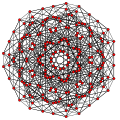 Pentitruncated 6-simplex | 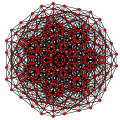 Penticantellated 6-simplex |
 Penticantitruncated 6-simplex |  Pentiruncitruncated 6-simplex |  Pentiruncicantellated 6-simplex |  Pentiruncicantitruncated 6-simplex |
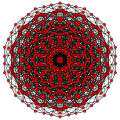 Pentisteritruncated 6-simplex |  Pentistericantitruncated 6-simplex |  Pentisteriruncicantitruncated 6-simplex (Omnitruncated 6-simplex) | |
Orthogonal projections in A6Coxeter plane | |||
|---|---|---|---|
In six-dimensional geometry, a pentellated 6-simplex is a convex uniform 6-polytope with 5th order truncations of the regular 6-simplex.
There are unique 10 degrees of pentellations of the 6-simplex with permutations of truncations, cantellations, runcinations, and sterications. The simple pentellated 6-simplex is also called an expanded 6-simplex, constructed by an expansion operation applied to the regular 6-simplex. The highest form, the pentisteriruncicantitruncated 6-simplex, is called an omnitruncated 6-simplex with all of the nodes ringed.
Contents
1 Pentellated 6-simplex
1.1 Alternate names
1.2 Coordinates
1.3 Root vectors
1.4 Images
2 Pentitruncated 6-simplex
2.1 Alternate names
2.2 Coordinates
2.3 Images
3 Penticantellated 6-simplex
3.1 Alternate names
3.2 Coordinates
3.3 Images
4 Penticantitruncated 6-simplex
4.1 Alternate names
4.2 Coordinates
4.3 Images
5 Pentiruncitruncated 6-simplex
5.1 Alternate names
5.2 Coordinates
5.3 Images
6 Pentiruncicantellated 6-simplex
6.1 Alternate names
6.2 Coordinates
6.3 Images
7 Pentiruncicantitruncated 6-simplex
7.1 Alternate names
7.2 Coordinates
7.3 Images
8 Pentisteritruncated 6-simplex
8.1 Alternate names
8.2 Coordinates
8.3 Images
9 Pentistericantitruncated 6-simplex
9.1 Alternate names
9.2 Coordinates
9.3 Images
10 Omnitruncated 6-simplex
10.1 Alternate names
10.2 Permutohedron and related tessellation
10.3 Coordinates
10.4 Images
11 Related uniform 6-polytopes
12 Notes
13 References
14 External links
Pentellated 6-simplex
| Pentellated 6-simplex | |
|---|---|
| Type | Uniform 6-polytope |
| Schläfli symbol | t0,5{3,3,3,3,3} |
| Coxeter-Dynkin diagram | |
| 5-faces | 126: 7+7 {34} 21+21 {}×{3,3,3} 35+35 {3}×{3,3} |
| 4-faces | 434 |
| Cells | 630 |
| Faces | 490 |
| Edges | 210 |
| Vertices | 42 |
| Vertex figure | 5-cell antiprism |
| Coxeter group | A6×2, [[3,3,3,3,3]], order 10080 |
| Properties | convex |
Alternate names
- Expanded 6-simplex
- Small terated tetradecapeton (Acronym: staf) (Jonathan Bowers)[1]
Coordinates
The vertices of the pentellated 6-simplex can be positioned in 7-space as permutations of (0,1,1,1,1,1,2). This construction is based on facets of the pentellated 7-orthoplex.
A second construction in 7-space, from the center of a rectified 7-orthoplex is given by coordinate permutations of:
- (1,-1,0,0,0,0,0)
Root vectors
Its 42 vertices represent the root vectors of the simple Lie group A6. It is the vertex figure of the 6-simplex honeycomb.
Images
| AkCoxeter plane | A6 | A5 | A4 |
|---|---|---|---|
| Graph |  |  | 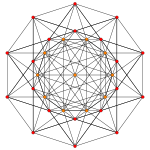 |
| Symmetry | [[7]](*)=[14] | [6] | [[5]](*)=[10] |
| Ak Coxeter plane | A3 | A2 | |
| Graph | 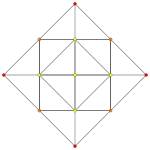 | 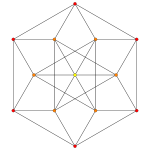 | |
| Symmetry | [4] | [[3]](*)=[6] |
- Note: (*) Symmetry doubled for Ak graphs with even k due to symmetrically-ringed Coxeter-Dynkin diagram.
Pentitruncated 6-simplex
| Pentitruncated 6-simplex | |
|---|---|
| Type | uniform 6-polytope |
| Schläfli symbol | t0,1,5{3,3,3,3,3} |
| Coxeter-Dynkin diagrams | |
| 5-faces | 126 |
| 4-faces | 826 |
| Cells | 1785 |
| Faces | 1820 |
| Edges | 945 |
| Vertices | 210 |
| Vertex figure | |
| Coxeter group | A6, [3,3,3,3,3], order 5040 |
| Properties | convex |
Alternate names
- Teracellated heptapeton (Acronym: tocal) (Jonathan Bowers)[2]
Coordinates
The vertices of the runcitruncated 6-simplex can be most simply positioned in 7-space as permutations of (0,1,1,1,1,2,3). This construction is based on facets of the runcitruncated 7-orthoplex.
Images
| AkCoxeter plane | A6 | A5 | A4 |
|---|---|---|---|
| Graph | 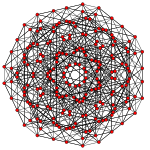 | 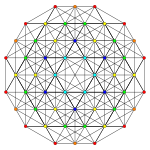 |  |
Dihedral symmetry | [7] | [6] | [5] |
| Ak Coxeter plane | A3 | A2 | |
| Graph | 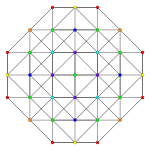 | 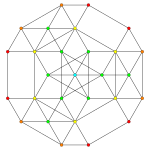 | |
| Dihedral symmetry | [4] | [3] |
Penticantellated 6-simplex
| Penticantellated 6-simplex | |
|---|---|
| Type | uniform 6-polytope |
| Schläfli symbol | t0,2,5{3,3,3,3,3} |
| Coxeter-Dynkin diagrams | |
| 5-faces | 126 |
| 4-faces | 1246 |
| Cells | 3570 |
| Faces | 4340 |
| Edges | 2310 |
| Vertices | 420 |
| Vertex figure | |
| Coxeter group | A6, [3,3,3,3,3], order 5040 |
| Properties | convex |
Alternate names
- Teriprismated heptapeton (Acronym: topal) (Jonathan Bowers)[3]
Coordinates
The vertices of the runcicantellated 6-simplex can be most simply positioned in 7-space as permutations of (0,1,1,1,1,2,3). This construction is based on facets of the penticantellated 7-orthoplex.
Images
| AkCoxeter plane | A6 | A5 | A4 |
|---|---|---|---|
| Graph | 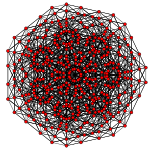 |  | 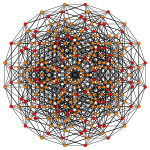 |
Dihedral symmetry | [7] | [6] | [5] |
| Ak Coxeter plane | A3 | A2 | |
| Graph |  | 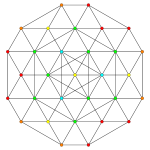 | |
| Dihedral symmetry | [4] | [3] |
Penticantitruncated 6-simplex
| penticantitruncated 6-simplex | |
|---|---|
| Type | uniform 6-polytope |
| Schläfli symbol | t0,1,2,5{3,3,3,3,3} |
| Coxeter-Dynkin diagrams | |
| 5-faces | 126 |
| 4-faces | 1351 |
| Cells | 4095 |
| Faces | 5390 |
| Edges | 3360 |
| Vertices | 840 |
| Vertex figure | |
| Coxeter group | A6, [3,3,3,3,3], order 5040 |
| Properties | convex |
Alternate names
- Terigreatorhombated heptapeton (Acronym: togral) (Jonathan Bowers)[4]
Coordinates
The vertices of the penticantitruncated 6-simplex can be most simply positioned in 7-space as permutations of (0,1,1,1,2,3,4). This construction is based on facets of the penticantitruncated 7-orthoplex.
Images
| AkCoxeter plane | A6 | A5 | A4 |
|---|---|---|---|
| Graph |  | 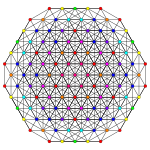 |  |
Dihedral symmetry | [7] | [6] | [5] |
| Ak Coxeter plane | A3 | A2 | |
| Graph |  | 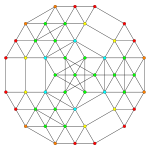 | |
| Dihedral symmetry | [4] | [3] |
Pentiruncitruncated 6-simplex
| pentiruncitruncated 6-simplex | |
|---|---|
| Type | uniform 6-polytope |
| Schläfli symbol | t0,1,3,5{3,3,3,3,3} |
| Coxeter-Dynkin diagrams | |
| 5-faces | 126 |
| 4-faces | 1491 |
| Cells | 5565 |
| Faces | 8610 |
| Edges | 5670 |
| Vertices | 1260 |
| Vertex figure | |
| Coxeter group | A6, [3,3,3,3,3], order 5040 |
| Properties | convex |
Alternate names
- Tericellirhombated heptapeton (Acronym: tocral) (Jonathan Bowers)[5]
Coordinates
The vertices of the pentiruncitruncated 6-simplex can be most simply positioned in 7-space as permutations of (0,1,1,1,2,3,4). This construction is based on facets of the pentiruncitruncated 7-orthoplex.
Images
| AkCoxeter plane | A6 | A5 | A4 |
|---|---|---|---|
| Graph | 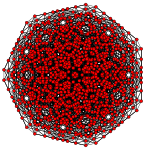 |  | 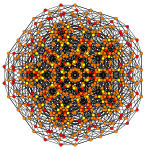 |
Dihedral symmetry | [7] | [6] | [5] |
| Ak Coxeter plane | A3 | A2 | |
| Graph |  |  | |
| Dihedral symmetry | [4] | [3] |
Pentiruncicantellated 6-simplex
| Pentiruncicantellated 6-simplex | |
|---|---|
| Type | uniform 6-polytope |
| Schläfli symbol | t0,2,3,5{3,3,3,3,3} |
| Coxeter-Dynkin diagrams | |
| 5-faces | 126 |
| 4-faces | 1596 |
| Cells | 5250 |
| Faces | 7560 |
| Edges | 5040 |
| Vertices | 1260 |
| Vertex figure | |
| Coxeter group | A6, [[3,3,3,3,3]], order 10080 |
| Properties | convex |
Alternate names
- Teriprismatorhombated tetradecapeton (Acronym: taporf) (Jonathan Bowers)[6]
Coordinates
The vertices of the pentiruncicantellated 6-simplex can be most simply positioned in 7-space as permutations of (0,1,1,2,3,3,4). This construction is based on facets of the pentiruncicantellated 7-orthoplex.
Images
| AkCoxeter plane | A6 | A5 | A4 |
|---|---|---|---|
| Graph |  | 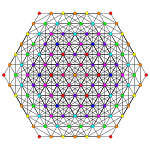 | 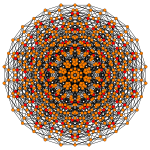 |
| Symmetry | [[7]](*)=[14] | [6] | [[5]](*)=[10] |
| Ak Coxeter plane | A3 | A2 | |
| Graph | 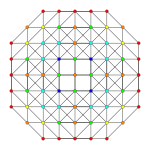 | 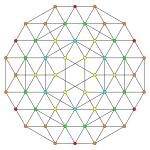 | |
| Symmetry | [4] | [[3]](*)=[6] |
- Note: (*) Symmetry doubled for Ak graphs with even k due to symmetrically-ringed Coxeter-Dynkin diagram.
Pentiruncicantitruncated 6-simplex
| Pentiruncicantitruncated 6-simplex | |
|---|---|
| Type | uniform 6-polytope |
| Schläfli symbol | t0,1,2,3,5{3,3,3,3,3} |
| Coxeter-Dynkin diagrams | |
| 5-faces | 126 |
| 4-faces | 1701 |
| Cells | 6825 |
| Faces | 11550 |
| Edges | 8820 |
| Vertices | 2520 |
| Vertex figure | |
| Coxeter group | A6, [3,3,3,3,3], order 5040 |
| Properties | convex |
Alternate names
- Terigreatoprismated heptapeton (Acronym: tagopal) (Jonathan Bowers)[7]
Coordinates
The vertices of the pentiruncicantitruncated 6-simplex can be most simply positioned in 7-space as permutations of (0,1,1,2,3,4,5). This construction is based on facets of the pentiruncicantitruncated 7-orthoplex.
Images
| AkCoxeter plane | A6 | A5 | A4 |
|---|---|---|---|
| Graph | 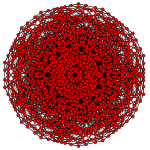 |  | 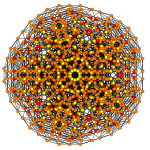 |
Dihedral symmetry | [7] | [6] | [5] |
| Ak Coxeter plane | A3 | A2 | |
| Graph | 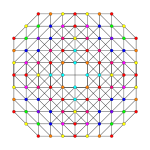 | 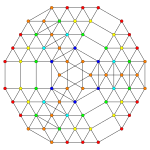 | |
| Dihedral symmetry | [4] | [3] |
Pentisteritruncated 6-simplex
| Pentisteritruncated 6-simplex | |
|---|---|
| Type | uniform 6-polytope |
| Schläfli symbol | t0,1,4,5{3,3,3,3,3} |
| Coxeter-Dynkin diagrams | |
| 5-faces | 126 |
| 4-faces | 1176 |
| Cells | 3780 |
| Faces | 5250 |
| Edges | 3360 |
| Vertices | 840 |
| Vertex figure | |
| Coxeter group | A6, [[3,3,3,3,3]], order 10080 |
| Properties | convex |
Alternate names
- Tericellitruncated tetradecapeton (Acronym: tactaf) (Jonathan Bowers)[8]
Coordinates
The vertices of the pentisteritruncated 6-simplex can be most simply positioned in 7-space as permutations of (0,1,2,2,2,3,4). This construction is based on facets of the pentisteritruncated 7-orthoplex.
Images
| AkCoxeter plane | A6 | A5 | A4 |
|---|---|---|---|
| Graph |  |  | 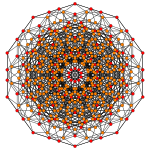 |
| Symmetry | [[7]](*)=[14] | [6] | [[5]](*)=[10] |
| Ak Coxeter plane | A3 | A2 | |
| Graph | 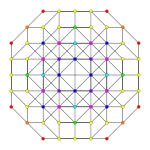 |  | |
| Symmetry | [4] | [[3]](*)=[6] |
- Note: (*) Symmetry doubled for Ak graphs with even k due to symmetrically-ringed Coxeter-Dynkin diagram.
Pentistericantitruncated 6-simplex
| pentistericantitruncated 6-simplex | |
|---|---|
| Type | uniform 6-polytope |
| Schläfli symbol | t0,1,2,4,5{3,3,3,3,3} |
| Coxeter-Dynkin diagrams | |
| 5-faces | 126 |
| 4-faces | 1596 |
| Cells | 6510 |
| Faces | 11340 |
| Edges | 8820 |
| Vertices | 2520 |
| Vertex figure | |
| Coxeter group | A6, [3,3,3,3,3], order 5040 |
| Properties | convex |
Alternate names
- Great teracellirhombated heptapeton (Acronym: gatocral) (Jonathan Bowers)[9]
Coordinates
The vertices of the pentistericantittruncated 6-simplex can be most simply positioned in 7-space as permutations of (0,1,2,2,3,4,5). This construction is based on facets of the pentistericantitruncated 7-orthoplex.
Images
| AkCoxeter plane | A6 | A5 | A4 |
|---|---|---|---|
| Graph |  |  |  |
Dihedral symmetry | [7] | [6] | [5] |
| Ak Coxeter plane | A3 | A2 | |
| Graph |  |  | |
| Dihedral symmetry | [4] | [3] |
Omnitruncated 6-simplex
| Omnitruncated 6-simplex | |
|---|---|
| Type | Uniform 6-polytope |
| Schläfli symbol | t0,1,2,3,4,5{35} |
| Coxeter-Dynkin diagrams | |
| 5-faces | 126: 14 t0,1,2,3,4{34} 42 {}×t0,1,2,3{33} 70 {6}×t0,1,2,3{3,3} |
| 4-faces | 1806 |
| Cells | 8400 |
| Faces | 16800: 4200 {6} 1260 {4} |
| Edges | 15120 |
| Vertices | 5040 |
| Vertex figure |  irregular 5-simplex |
| Coxeter group | A6, [[35]], order 10080 |
| Properties | convex, isogonal, zonotope |
The omnitruncated 6-simplex has 5040 vertices, 15120 edges,16800 faces (4200 hexagons and 1260 squares), 8400 cells, 1806 4-faces, and 126 5-faces. With 5040 vertices, it is the largest of 35 uniform 6-polytopes generated from the regular 6-simplex.
Alternate names
- Pentisteriruncicantitruncated 6-simplex (Johnson's omnitruncation for 6-polytopes)
- Omnitruncated heptapeton
- Great terated tetradecapeton (Acronym: gotaf) (Jonathan Bowers)[10]
The omnitruncated 6-simplex is the permutohedron of order 7. The omnitruncated 6-simplex is a zonotope, the Minkowski sum of seven line segments parallel to the seven lines through the origin and the seven vertices of the 6-simplex.
Like all uniform omnitruncated n-simplices, the omnitruncated 6-simplex can tessellate space by itself, in this case 6-dimensional space with three facets around each hypercell. It has Coxeter-Dynkin diagram of ![]()
![]()
![]()
![]()
![]()
![]()
![]() .
.
Coordinates
The vertices of the omnitruncated 6-simplex can be most simply positioned in 7-space as permutations of (0,1,2,3,4,5,6). This construction is based on facets of the pentisteriruncicantitruncated 7-orthoplex, t0,1,2,3,4,5{35,4}, ![]()
![]()
![]()
![]()
![]()
![]()
![]()
![]()
![]()
![]()
![]()
![]()
![]() .
.
Images
| AkCoxeter plane | A6 | A5 | A4 |
|---|---|---|---|
| Graph | 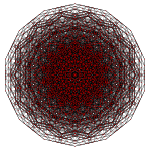 | 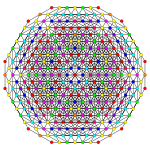 | 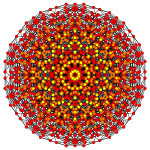 |
| Symmetry | [[7]](*)=[14] | [6] | [[5]](*)=[10] |
| Ak Coxeter plane | A3 | A2 | |
| Graph |  | 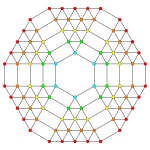 | |
| Symmetry | [4] | [[3]](*)=[6] |
- Note: (*) Symmetry doubled for Ak graphs with even k due to symmetrically-ringed Coxeter-Dynkin diagram.
Related uniform 6-polytopes
The pentellated 6-simplex is one of 35 uniform 6-polytopes based on the [3,3,3,3,3] Coxeter group, all shown here in A6Coxeter plane orthographic projections.
| A6 polytopes | |||||||||||
|---|---|---|---|---|---|---|---|---|---|---|---|
 t0 |  t1 |  t2 |  t0,1 |  t0,2 |  t1,2 |  t0,3 |  t1,3 |  t2,3 | |||
 t0,4 |  t1,4 |  t0,5 |  t0,1,2 |  t0,1,3 |  t0,2,3 |  t1,2,3 |  t0,1,4 |  t0,2,4 | |||
 t1,2,4 |  t0,3,4 |  t0,1,5 |  t0,2,5 |  t0,1,2,3 |  t0,1,2,4 |  t0,1,3,4 |  t0,2,3,4 |  t1,2,3,4 | |||
 t0,1,2,5 |  t0,1,3,5 |  t0,2,3,5 |  t0,1,4,5 |  t0,1,2,3,4 |  t0,1,2,3,5 |  t0,1,2,4,5 |  t0,1,2,3,4,5 | ||||
Notes
^ Klitzing, (x3o3o3o3o3x - staf)
^ Klitzing, (x3x3o3o3o3x - tocal)
^ Klitzing, (x3o3x3o3o3x - topal)
^ Klitzing, (x3x3x3o3o3x - togral)
^ Klitzing, (x3x3o3x3o3x - tocral)
^ Klitzing, (x3o3x3x3o3x - taporf)
^ Klitzing, (x3x3x3o3x3x - tagopal)
^ Klitzing, (x3x3o3o3x3x - tactaf)
^ Klitzing, (x3x3x3o3x3x - gatocral)
^ Klitzing, (x3x3x3x3x3x - gotaf)
References
H.S.M. Coxeter:
- H.S.M. Coxeter, Regular Polytopes, 3rd Edition, Dover New York, 1973
Kaleidoscopes: Selected Writings of H.S.M. Coxeter, edited by F. Arthur Sherk, Peter McMullen, Anthony C. Thompson, Asia Ivic Weiss, Wiley-Interscience Publication, 1995, .mw-parser-output cite.citation{font-style:inherit}.mw-parser-output .citation q{quotes:"""""""'""'"}.mw-parser-output .citation .cs1-lock-free a{background:url("//upload.wikimedia.org/wikipedia/commons/thumb/6/65/Lock-green.svg/9px-Lock-green.svg.png")no-repeat;background-position:right .1em center}.mw-parser-output .citation .cs1-lock-limited a,.mw-parser-output .citation .cs1-lock-registration a{background:url("//upload.wikimedia.org/wikipedia/commons/thumb/d/d6/Lock-gray-alt-2.svg/9px-Lock-gray-alt-2.svg.png")no-repeat;background-position:right .1em center}.mw-parser-output .citation .cs1-lock-subscription a{background:url("//upload.wikimedia.org/wikipedia/commons/thumb/a/aa/Lock-red-alt-2.svg/9px-Lock-red-alt-2.svg.png")no-repeat;background-position:right .1em center}.mw-parser-output .cs1-subscription,.mw-parser-output .cs1-registration{color:#555}.mw-parser-output .cs1-subscription span,.mw-parser-output .cs1-registration span{border-bottom:1px dotted;cursor:help}.mw-parser-output .cs1-ws-icon a{background:url("//upload.wikimedia.org/wikipedia/commons/thumb/4/4c/Wikisource-logo.svg/12px-Wikisource-logo.svg.png")no-repeat;background-position:right .1em center}.mw-parser-output code.cs1-code{color:inherit;background:inherit;border:inherit;padding:inherit}.mw-parser-output .cs1-hidden-error{display:none;font-size:100%}.mw-parser-output .cs1-visible-error{font-size:100%}.mw-parser-output .cs1-maint{display:none;color:#33aa33;margin-left:0.3em}.mw-parser-output .cs1-subscription,.mw-parser-output .cs1-registration,.mw-parser-output .cs1-format{font-size:95%}.mw-parser-output .cs1-kern-left,.mw-parser-output .cs1-kern-wl-left{padding-left:0.2em}.mw-parser-output .cs1-kern-right,.mw-parser-output .cs1-kern-wl-right{padding-right:0.2em}
ISBN 978-0-471-01003-6 [1]
- (Paper 22) H.S.M. Coxeter, Regular and Semi Regular Polytopes I, [Math. Zeit. 46 (1940) 380-407, MR 2,10]
- (Paper 23) H.S.M. Coxeter, Regular and Semi-Regular Polytopes II, [Math. Zeit. 188 (1985) 559-591]
- (Paper 24) H.S.M. Coxeter, Regular and Semi-Regular Polytopes III, [Math. Zeit. 200 (1988) 3-45]
Norman Johnson Uniform Polytopes, Manuscript (1991)
- N.W. Johnson: The Theory of Uniform Polytopes and Honeycombs, Ph.D.
Klitzing, Richard. "6D uniform polytopes (polypeta)". x3o3o3o3o3x - staf, x3x3o3o3o3x - tocal, x3o3x3o3o3x - topal, x3x3x3o3o3x - togral, x3x3o3x3o3x - tocral, x3x3x3x3o3x - tagopal, x3x3o3o3x3x - tactaf, x3x3x3o3x3x - tacogral, x3x3x3x3x3x - gotaf
External links
Glossary for hyperspace, George Olshevsky.- Polytopes of Various Dimensions
- Multi-dimensional Glossary
Fundamental convex regular and uniform polytopes in dimensions 2–10 | ||||||||||||
|---|---|---|---|---|---|---|---|---|---|---|---|---|
Family | An | Bn | I2(p) / Dn | E6 / E7 / E8 / F4 / G2 | Hn | |||||||
Regular polygon | Triangle | Square | p-gon | Hexagon | Pentagon | |||||||
Uniform polyhedron | Tetrahedron | Octahedron • Cube | Demicube | Dodecahedron • Icosahedron | ||||||||
Uniform 4-polytope | 5-cell | 16-cell • Tesseract | Demitesseract | 24-cell | 120-cell • 600-cell | |||||||
Uniform 5-polytope | 5-simplex | 5-orthoplex • 5-cube | 5-demicube | |||||||||
Uniform 6-polytope | 6-simplex | 6-orthoplex • 6-cube | 6-demicube | 122 • 221 | ||||||||
Uniform 7-polytope | 7-simplex | 7-orthoplex • 7-cube | 7-demicube | 132 • 231 • 321 | ||||||||
Uniform 8-polytope | 8-simplex | 8-orthoplex • 8-cube | 8-demicube | 142 • 241 • 421 | ||||||||
Uniform 9-polytope | 9-simplex | 9-orthoplex • 9-cube | 9-demicube | |||||||||
Uniform 10-polytope | 10-simplex | 10-orthoplex • 10-cube | 10-demicube | |||||||||
| Uniform n-polytope | n-simplex | n-orthoplex • n-cube | n-demicube | 1k2 • 2k1 • k21 | n-pentagonal polytope | |||||||
| Topics: Polytope families • Regular polytope • List of regular polytopes and compounds | ||||||||||||